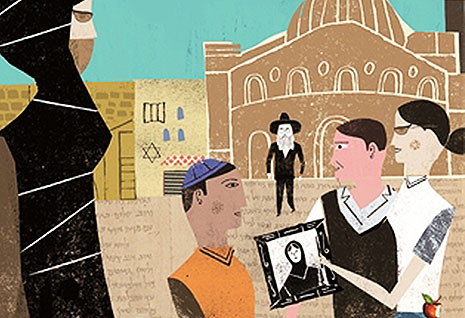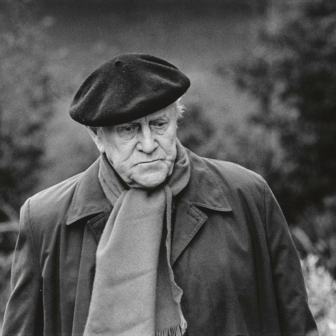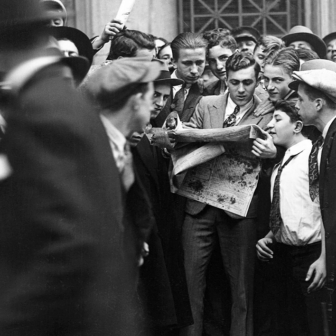The Mandelbaum Gate
By Muriel Spark | Virago | $24.99
THE German illustrator Martin Haake often works with collage, cutting out his figures and positioning them against a background, then digitally manipulating them to suggest a curious combination of interconnection and isolation. One result is that Haake’s human figures retain, when reproduced on the perfectly flat surfaces of his book covers or on the maps that he is partial to creating, their unsettlingly stuck-on quality, as if they simultaneously belong and don’t belong to the background onto which they have been so carefully placed. Which makes Haake, with his characteristic layering method, a particularly appropriate choice to illustrate the cover for the recent reissue, by Virago Modern Classics, of Muriel Spark’s novel of displacement, The Mandelbaum Gate. It is a cover to draw the eye, and to suggest the novel’s subtle originality, much more so in fact than the few brief words – “a well-wrought and stimulating novel… hard to forget” – that appear below the title, extracted from a contemporary review by Anthony Burgess and unlikely, of themselves, to create a competitive scuffle around a display table piled high with recent re-releases.
The Mandelbaum Gate was first published in 1965, but it is set four years earlier, in 1961, in the swirling complexity of a Jerusalem divided between Israel and Jordan, a world of “sides” that are personal and emotional as well as geopolitical and religious. Named for the crossing point between the two countries, the novel is populated by a large cast of characters who seem stuck on to the backdrop and only tangentially connected to one another, people who are just visiting, or there for a finite time, or waiting apprehensively for something to happen, people who are forever crossing back and forth, or anxious to leave altogether and try somewhere else. They are people whose real stake in this part of the world is never clear, even to themselves.
It was in 1961 that the Nazi functionary Adolf Eichmann was committed to public trial in Jerusalem for war crimes and crimes against humanity. Spark makes several passing references in the first half of the novel to the trial, foreshadowing a set-piece that comes just over halfway through, in which her heroine, Barbara Vaughan, on a pilgrimage to the Holy Land, attends the trial at the urging of others – a cousin and some recent acquaintances – who are keen that she should take the opportunity to see history being made. Barbara arrives in the courtroom at a point where proceedings have “entered a boring phase.” The period of gruelling personal testimony from eyewitnesses and survivors is over, and Eichmann, encased in the bulletproof glass booth that became one of the defining images of those years, is being examined “by his own counsel, in a long drawn-out routine, document by patient document.” Barbara is suddenly struck by the recognition that “this dull phase was in reality the desperate heart of the trial.” Picking up on faint echoes of Hannah Arendt’s famous phrase “the banality of evil,” coined in respect of Eichmann’s bureaucratic and dutiful efficiency as a mass murderer, Barbara is confronted by the impossibility of understanding. She switches to other, simultaneous translations – “French, Italian, then back to English” – to no avail. “What was he talking about?” she asks herself.
Vaughan is, by her own estimation, “a spinster of no fixed identity,” a woman who embodies contradictions – a half-Jewish Catholic convert (like Spark herself), prim but sensual, serious as well as frivolous, wavering yet determined. In fact, “Barbara Vaughan was in a state of conflict, like practically everyone else,” a phrase that has a special resonance in the context of Palestine, of disputed histories and disputed identities. Her motives in travelling to Israel are equally contradictory. She is coming to meet her lover, an archaeologist who is conducting a dig across the border in Jordan and who is subjecting himself, at her behest, to the arcane processes of the Catholic Church as he tries to seek an annulment of his first marriage. The annulment is necessary because Barbara, in deference to her faith, cannot bring herself to marry him without it, and indeed he does in due course gain the Church’s approval. But, in a manner typical of Muriel Spark, there is twist upon twist. The annulment is granted on the basis of a document that, unbeknownst to either Barbara or her lover, is a forgery. And besides, Barbara in effect declares, she would have married him anyway. It turns out that faith governs rules, rather than the other way around.
If Muriel Spark’s novels are lined up on a shelf, it is easy to spot The Mandelbaum Gate, even from the other side of the room. It is the one with the spine that is two or three times wider than any of the others. The novels that came both before and after are short, allusive, funny (and often macabre), formally inventive, perhaps even “experimental,” yet a breeze to read, the kinds of novels that are sometimes characterised, in a phrase that comes across as dismissive while pretending not to be, as “deceptively slight.” When it appeared, The Mandelbaum Gate seemed to be an exception, not in terms of its readability, which is equal to Spark’s other fiction, but in the way it suggests a deliberate attempt to write a (literally) substantial novel of a more conventional kind, with characters and plot set against the background of recent events, where figures who defined the era came and went – not only Eichmann and the judges and lawyers at his trial, but others too, like the smiling Soviet cosmonaut Yuri Gagarin who, as it happens, completed his orbit of the earth the day after the Eichmann trial began. There is even, in a rather different register, a passing reference to Australia’s objections in the early 1960s to Britain’s attempts to join the Common Market. (“Australia should keep her nose out of it,” says the British diplomat Freddy Hamilton sharply.) Yet for all these trappings of more conventional fiction, it is hard to see how, as Muriel Spark’s biographer Martin Stannard describes it, her publishers could have greeted the completed manuscript as a “rattling yarn with a ‘big’ central character and no stylistic tricksiness.”
Spark was always above tricksiness, but that does not mean that The Mandelbaum Gate is conventional in either structure or narrative. Part of the compelling readability of Muriel Spark’s fiction comes not from plot, which in the case of The Mandelbaum Gate is confusingly complex, nor from character, which is often shown to be contradictory and unpredictable, but from the feeling she instils of lives and events having a preordained course that they must follow, in response to a sense of inevitability and even destiny rather than mere chance or authorial whim. Information is withheld by Spark and then suddenly released, the future is revealed before the present or the past, the plot spins out into the realm of absurdity while remaining fixed in a recognisable world of actions and consequences. Violence, which is so embedded into the fabric of the contested territory that forms the novel’s background, but which seems quite remote from the experience of sojourners like Barbara Vaughan or Freddy Hamilton, can impinge just as easily on these visitors from far away. “I’ve got a premonition of bloodshed,” says Freddy, a refrain that echoes throughout the novel. But what Freddy with his premonitions does not foresee is that when, by means of an extravagant plot device, blood is indeed shed, it is not in the political maelstrom that is Jerusalem but somewhere that is, for Freddy, much closer to home. •




